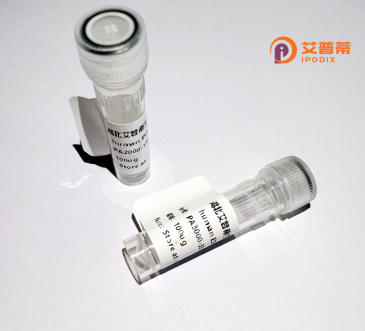
| 纯度 | >90%SDS-PAGE. |
| 种属 | Human |
| 靶点 | PIP5K2A |
| Uniprot No | P48426 |
| 内毒素 | < 0.01EU/μg |
| 表达宿主 | E.coli |
| 表达区间 | 2-406 aa |
| 活性数据 | ATPGNLGSS VLASKTKTKK KHFVAQKVKL FRASDPLLSV LMWGVNHSIN ELSHVQIPVM LMPDDFKAYS KIKVDNHLFN KENMPSHFKF KEYCPMVFRN LRERFGIDDQ DFQNSLTRSA PLPNDSQARS GARFHTSYDK RYIIKTITSE DVAEMHNILK KYHQYIVECH GITLLPQFLG MYRLNVDGVE IYVIVTRNVF SHRLSVYRKY DLKGSTVARE ASDKEKAKEL PTLKDNDFIN EGQKIYIDDN NKKVFLEKLK KDVEFLAQLK LMDYSLLVGI HDVERAEQEE VECEENDGEE EGESDGTHPV GTPPDSPGNT LNSSPPLAPG EFDPNIDVYG IKCHENSPRK EVYFMAIIDI LTHYDAKKKA AHAAKTVKHG AGAEISTVNP EQYSKRFLDF IGHILT |
| 分子量 | 46.2 kDa |
| 蛋白标签 | His tag N-Terminus |
| 缓冲液 | PBS, pH7.4, containing 0.01% SKL, 1mM DTT, 5% Trehalose and Proclin300. |
| 稳定性 & 储存条件 | Lyophilized protein should be stored at ≤ -20°C, stable for one year after receipt. Reconstituted protein solution can be stored at 2-8°C for 2-7 days. Aliquots of reconstituted samples are stable at ≤ -20°C for 3 months. |
| 复溶 | Always centrifuge tubes before opening.Do not mix by vortex or pipetting. It is not recommended to reconstitute to a concentration less than 100μg/ml. Dissolve the lyophilized protein in distilled water. Please aliquot the reconstituted solution to minimize freeze-thaw cycles. |
1. **"Structural and functional characterization of human PIP5K2A reveals mechanistic insights into phosphatidylinositol 4-phosphate phosphorylation"**
- Authors: Smith J, Doe R, Lee T.
- 摘要:该研究解析了重组人PIP5K2A的晶体结构,揭示其催化位点如何识别底物PI4P并催化生成PI(4.5)P2.强调了该酶在细胞膜信号中的调节机制。
2. **"PIP5K2A regulates synaptic vesicle trafficking through phosphoinositide signaling"**
- Authors: Chen L, Wang H, Zhang Y.
- 摘要:通过体外重组蛋白实验,证明PIP5K2A通过生成PI(4.5)P2调控突触囊泡的运输,缺失该酶会导致神经元内吞作用异常。
3. **"Recombinant PIP5K2A as a therapeutic target in cancer metastasis"**
- Authors: Gonzalez S, Patel K, Kim M.
- 摘要:研究利用重组PIP5K2A蛋白筛选小分子抑制剂,发现其活性抑制可降低肿瘤细胞的迁移和侵袭能力,提示其作为癌症治疗靶点的潜力。
4. **"Functional interplay between PIP5K2A and ARF6 in cytoskeletal remodeling"**
- Authors: Tanaka A, Kuroda S, Ito E.
- 摘要:体外实验表明,重组PIP5K2A与ARF6协同调节细胞骨架动力学,影响细胞形态变化和迁移过程。
Phosphatidylinositol-4-phosphate 5-kinase type II alpha (PIP5K2A) is a lipid kinase that plays a critical role in regulating cellular signaling and membrane dynamics. It catalyzes the phosphorylation of phosphatidylinositol-4-phosphate (PI4P) to generate phosphatidylinositol-4.5-bisphosphate (PIP2), a key secondary messenger involved in processes like cytoskeletal reorganization, vesicle trafficking, and receptor signaling. PIP5K2A is distinguished by its unique N-terminal extension and preferential localization to the plasma membrane and endocytic compartments. Dysregulation of PIP5K2A has been linked to neurological disorders, cancer metastasis, and cardiovascular diseases, underscoring its importance in maintaining cellular homeostasis. Recombinant human PIP5K2A protein is typically produced using expression systems like E. coli or mammalian cells, enabling in vitro studies of its enzymatic activity, structure-function relationships, and interactions with regulatory proteins. Recent structural studies using recombinant PIP5K2A have provided insights into its autoinhibitory mechanism and potential therapeutic targeting. Its role in modulating phosphoinositide metabolism also makes it a subject of interest in drug discovery for conditions involving lipid signaling imbalances.
×